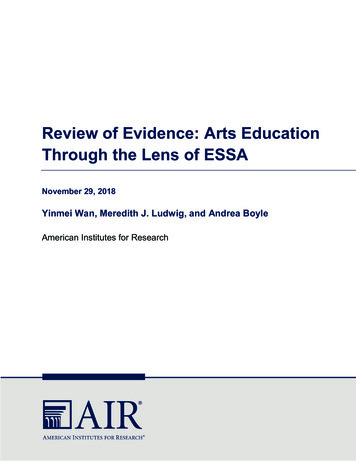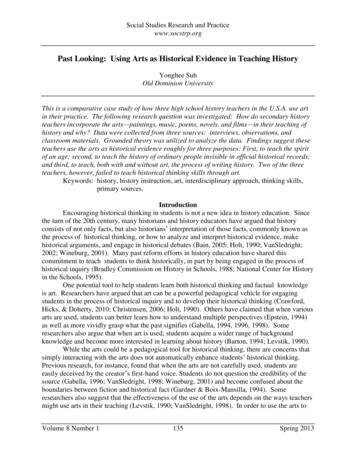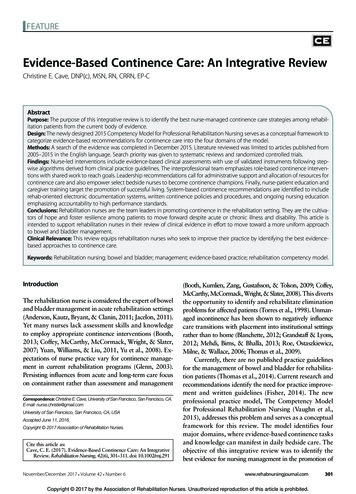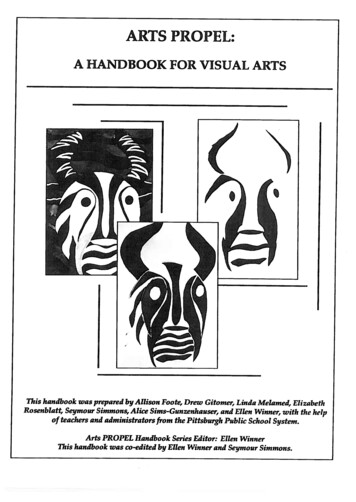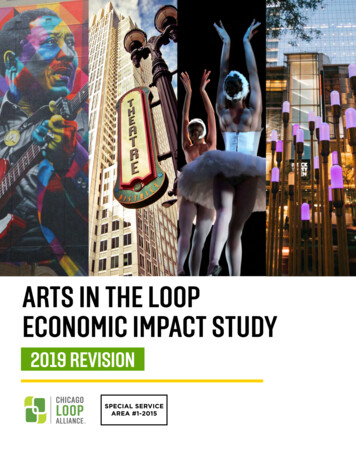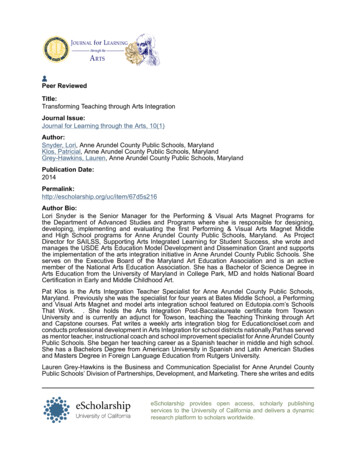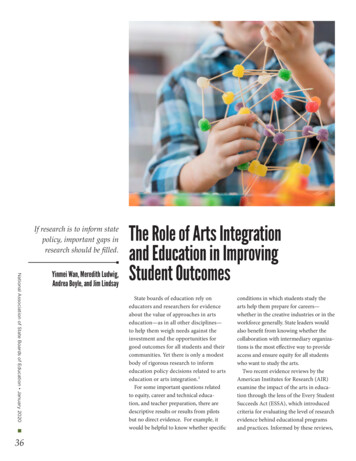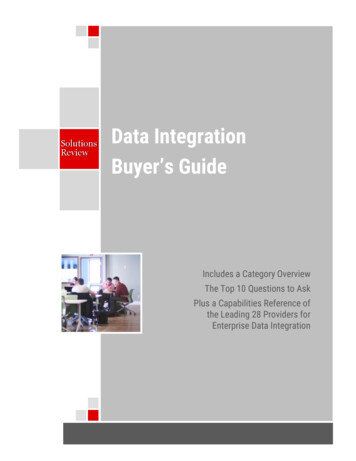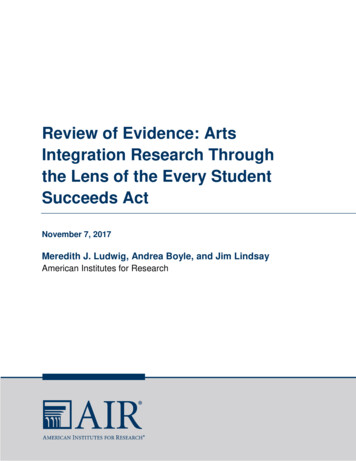
Transcription
Review of Evidence: ArtsIntegration Research Throughthe Lens of the Every StudentSucceeds ActNovember 7, 2017Meredith J. Ludwig, Andrea Boyle, and Jim LindsayAmerican Institutes for Research
Review of Evidence: Arts IntegrationResearch Through the Lens of theEvery Student Succeeds ActNovember 7, 2017Meredith J. Ludwig, Andrea Boyle, and Jim Lindsay1000 Thomas Jefferson Street NWWashington, DC 20007-3835202.403.5000www.air.orgCopyright 2017 American Institutes for Research. All rights reserved.This research was commissioned and funded by The Wallace Foundation as part of its mission tosupport and share effective ideas and practices.
AcknowledgmentsWe express our gratitude to the staff of The Wallace Foundation, in particular Rachel Hare Bork,Ed Pauly, and Sarosh Syed. Their questions, suggestions, and comments helped us improve thecontent and style of the report. We also wish to thank the many colleagues who helped us. Weappreciate the corrections and recommendations of Kathryn Young of Education Counsel, whochecked our presentation of the key elements in the Every Student Succeeds Act (ESSA) as theypertain to arts interventions. Rebecca Herman and colleagues from Rand Corporation offeredtheir experience and analysis. David English informed our description of ESSA and the arts, andMengli Song provided feedback on the technical parts of this report (both of American Institutesfor Research). We take full responsibility for any errors.
ContentsPageAcknowledgments . iiiExecutive Summary . 1Report Highlights . 2Recommendations . 3Chapter 1. What Is Arts Integration? . 5Components, Processes, and Outcomes: A Logic Model of Arts IntegrationInterventions . 7Organization of This Report . 10Chapter 2. How Can the Every Student Succeeds Act Support Arts Integration, and HowDoes It Define Evidence-Based Interventions? . 11Support for Arts Integration Within ESSA . 11Identifying the Evidence Base of Arts Integration Interventions . 19Chapter 3. What Evidence Exists Linking Arts Integration With Improved StudentOutcomes? . 22Evidence Supporting Arts Integration Interventions for Students in Early ElementaryGrades: Prekindergarten–Grade 2 . 23Evidence Supporting Arts Integration Interventions for Students in Elementary andMixed Elementary School Grade Levels (up to Grade 8) . 28Evidence Supporting Arts Integration Interventions for Students in Mixed Grade LevelsUp to Grade 12 . 33Summary . 37Chapter 4. How Large Are the Effects of Arts Integration Interventions on StudentOutcomes? . 38Average Effect of Arts Integration on Student Outcomes . 40Summary . 46Chapter 5. Recommendations . 47Recommendations for Practitioners and Policymakers . 47Recommendations for Future Research . 47References . 49Appendix A. Descriptions of Arts Integration Interventions Examined in the EvidenceReview . 57Appendix B. Studies—No ESSA Tier-Aligned Evidence . 73Appendix C. Technical Approach to the Evidence Review . 78Appendix D. Supplemental Findings From Meta-Analysis . 89
TablesPageTable 2.1. Opportunities for Funding, Evidence Required for Funding, and Eligible ESSAArts-Related Activities . 13Table 3.1. Studies Involving Students in Early Elementary Grades (Prekindergarten—Grade 2) That Provide Evidence at Tiers II–III . 25Table 3.2. Studies Involving Students in Early Elementary Grades (Prekindergarten—Grade 2) That Provide Evidence at Tier IV . 27Table 3.3. Studies Involving Students in Elementary and Mixed Elementary Grades (up toGrade 8) That Provide Evidence at Tier III . 29Table 3.4. Studies Involving Students in Elementary and Mixed Elementary Grades (Up toGrade 8) That Provide Evidence at Tier IV . 31Table 3.5. Studies Involving Students in Mixed Grade Levels (up to Grade 12) ThatProvide Evidence at Tiers I–III . 34Table 3.6. Studies Involving Students in Mixed Grade Levels (up to Grade 12) ThatProvide Evidence at Tier IV . 36Table 4.1 Average Effects of Arts Integration Interventions on Different Types of StudentOutcomes . 42Table 4.2. Average Effect Sizes for Samples With Different Characteristics . 45Table A.1. Descriptions of Arts Integration Interventions as Implemented in StudiesInvolving Students in Early Elementary School Grades (Prekindergarten—Grade 2) . 57Table A.2. Descriptions of Arts Integration Interventions as Implemented in StudiesInvolving Samples Made Up Mostly of Students in Grades 3–5. 61Table A.3. Descriptions of Arts Integration Interventions as Implemented in StudiesInvolving Samples Made Up Mostly of Students in Grades 6–12 . 69Table B.1. Studies—No ESSA-Tier Aligned Evidence . 73Table C.1. Criteria for Determining Tier of Evidence Based on ESSA and U.S. Departmentof Education’s Supplemental Guidance . 82Table C.2. Types of Study Features Recorded From Each Eligible Study Report. 84Table D.1. Variation of Average Effect Sizes by Study Characteristics (Moderator Analysis) . 90Table D.2. Variation of Average Effect Sizes by Sample Characteristics (Moderator Analysis) . 91Table D.3. Variation of Effect Sizes by Characteristics of Arts Integration Interventions(Moderator Analysis) . 92
FiguresPageFigure ES.1. Evidence of the Effects of Arts Integration Interventions on StudentOutcomes: Number of Interventions by Grade Level and Tier of Evidence . 3Figure 1.1. Logic Model for Arts Integration Interventions . 9Figure 2.1. “Evidence-Based” Intervention as Defined by ESSA . 19Figure 3.1. Evidence of the Effects of Arts Integration Interventions on StudentOutcomes: Number of Interventions by Grade Level and Tier of Evidence . 22Figure 4.1. Average Effects of Arts Integration Interventions on Student Outcomes Withinand Across Studies . 41Figure 4.2 Distribution of Improvement Indices for Intervention Effects on StudentAchievement in Mathematics, Reading, and Science Based on What Works Clearinghouse–Reviewed Intervention Reports . 43Figure C.1. Disposition of Reports of Studies of Arts Integration Interventions Found inThis Evidence Review . 83Figure C.2. Examples of Possible Effects of an Arts Integration Intervention on StudentAcademic Achievement . 86Figure C.3. Interpreting the Improvement Index . 87BoxesPageBox ES.1. Definitions of Key Terms . 2Box 1.1. Definition of Terms . 6Box 1.2. Key Components of Arts Integration Interventions . 8Box 2.1. Types of Rationales as Tier IV Evidence . 21Box 4.1. Meta-Analysis Explained . 39Box C.1. Extent of Literature Search. 80Box D.1. Description and Number of Studies Included in Meta-Analysis. 89
ESSA Arts Integration Evidence ReviewExecutive SummaryDuring the past 20 years, education scholars and researchers have argued that linking artsstrategies and activities with curriculum and instruction in other subjects (e.g., mathematics,reading, science, and social studies) can improve student learning in those subjects. Thisapproach of incorporating the arts in other subjects is referred to as arts integration (see, forexample, Arts Education Partnership, 2004; Burnaford, Brown, Doherty, & McLaughlin, 2007;Deasy, 2002).This report examines the relevance of arts integration to the Every Student Succeeds Act (ESSA),the 2015 reauthorization of the Elementary and Secondary Education Act. ESSA includes adiverse array of programs and funding streams that states, local educational agencies, andschools might leverage to support school improvement and student success. Furthermore, ESSAcontains provisions requiring that educational agencies seeking to use federal funds availablethrough the law adopt evidence-based interventions.The report then presents the results of a review of evidence about arts integration based on thenew evidence requirements in ESSA. According to ESSA, for an intervention to be evidencebased, research or theoretical support for the intervention must fall within one of four evidencetiers. Evidence in Tiers I–III must “demonstrate a statistically significant effect on improvingstudent outcomes or other relevant outcomes,” and the three tiers represent varying levels ofrigor from “strong evidence” to “promising evidence.” Tier IV evidence must “demonstrate arationale” that an intervention is “likely to improve student outcomes or other relevantoutcomes,” and it must be coupled with “ongoing efforts to examine the effects” of theintervention (ESSA, Title VIII, Section 8101(21)(A)). School improvement activities fundedthrough ESSA (Title I, section 1003) must include at least one intervention in one of the firstthree tiers. This report examines arts integration research through the lens of these four tiers.The evidence review addresses two research questions:1. Are there research studies on arts integration that meet the criteria for evidence as specifiedin ESSA?2. How large are the effects of arts integration interventions on student outcomes, particularlyfor students who are disadvantaged?To answer these two questions, we undertook four steps:1. We conducted a comprehensive search of educational databases and clearinghouses toidentify reports about the implementation and outcomes of arts integration interventions.The search focused on research reported since 2000. The number of reports found throughthis search was 1,619.2. Our search was refined as we screened abstracts and then full-text documents with a focuson finding empirical studies with data about student outcomes in prekindergarten throughGrade 12. We screened out ineligible abstracts and texts and identified 135 reports ofstudies appropriate for review by What Works Clearinghouse-certified reviewers.American Institutes for Research1
ESSA Arts Integration Evidence Review3. We examined the reports that contained studies of arts integration interventions andclassified the studies according to definitions of the ESSA tiers of evidence(I–IV).4. Finally, to gain a fuller picture of the research findings on arts integration across all the welldesigned studies, we recorded the magnitude of effects from 27 studies of interventions andmeta-analyzed those effect sizes.Box ES.1 provides definitions to clarify the distinctions among some of the key terms used in thisevidence review report.Box ES.1. Definitions of Key TermsArts integration intervention: A specific approach, set of activities, strategy, or program linking arts with at leastone other subject to improve student and school-related outcomes.Study: An empirical investigation of the effect of an arts integration intervention on a particular sample and setof outcomes. The findings (single or multiple findings) from a single study can appear in a single report or inmultiple reports.Report: A written summary of a study, in the form of a journal article, a book or book chapter, a dissertation, atechnical report, or a conference paper. A report may present findings from a single study or multiple studies.The results of a study of an intervention may appear in multiple reports, such as consecutive evaluation reportsof a multiyear implementation of arts integration.Report HighlightsArts integration takes many forms and can be observed in specific strategies, activities, andmultifaceted interventions. Descriptions of arts integration interventions in the literature identifysome common components, such as professional development opportunities, the use ofspecialized personnel, and the use of specialized instructional materials.ESSA includes at least 12 different funding opportunities that state educational agencies, localeducational agencies, and schools can use to implement arts integration interventions forstudents in all grades, from prekindergarten to Grade 12. These funding opportunities can beused to support activities such as teacher professional development, school improvement efforts,supports for English learners, arts integration courses, instructional materials, extended learningtime programs. They can also be used to support arts-focused charter or magnet schools.ESSA addresses the issue of arts education—and, more specifically, arts integration—in severalways. It maintains an emphasis throughout its varied funding streams on ensuring that studentshave access to a “well-rounded education,” which, according to the law, can include “the arts”and “music” along with other subjects. Title IV of ESSA explicitly identifies programs in the artsand arts integration as allowable activities, and it provides for dedicated assistance for artseducation. ESSA also offers funding for arts integration interventions that address the needs ofspecific student subgroups, such as economically disadvantaged students and English learners.Evidence of the effects of arts integration on student outcomes exists at all four ESSA evidencetiers. However, most arts integration interventions included in this review are supported by Tier IVevidence only. As Figure ES.1 illustrates, this review identified a total of 44 interventions withevidence in one or more of the four tiers. Ten of those interventions met the evidenceAmerican Institutes for Research2
ESSA Arts Integration Evidence Reviewrequirements for Tiers I–III, including one intervention that met requirements for the mostrigorous tier, Tier I. The other 34 interventions had evidence in Tier IV only; that is, reports onthese interventions lack empirical results from rigorous studies, but they do contain a theory- orresearch-based rationale for why the intervention should improve student outcomes. Our reviewidentified one study with countervailing evidence that is not reported in Figure ES.1.Figure ES.1. Evidence of the Effects of Arts Integration Interventions on Student Outcomes:Number of Interventions by Grade Level and Tier of EvidenceTotal interventions (All Grades Combined) 19Early Elementary (PreK-2)3Elementary and Mixed Elementary Grades (up toGrade 8)4Mixed Grade Levels (up to Grade 12) 1 23461990204060Number of InterventionsTier ITiers II-IIITier IVNote. Two interventions that focus on students in early elementary grades and one intervention that focuses onstudents in mixed elementary grades were supported by evidence at multiple tiers. In the figure, these interventionsare counted just once, in the higher-level tier (indicating stronger evidence).According to a meta-analysis conducted as part of this evidence review, the average effect foundin the 27 well-designed studies examined was statistically significant but modest in magnitude.Based on the average effect across all 27 studies that met design requirements for Tiers I–III,one can expect an average child to gain four percentile points in achievement as a result of anarts integration intervention. The four-percentile-point increase would put the average effect ofarts integration interventions at the 30th percentile among the interventions in mathem
Arts integration intervention: A specific approach, set of activities, strategy, or program linking arts with at least one other subject to improve student and school-related outcomes. Study: An empirical investigation of the effect of an arts
